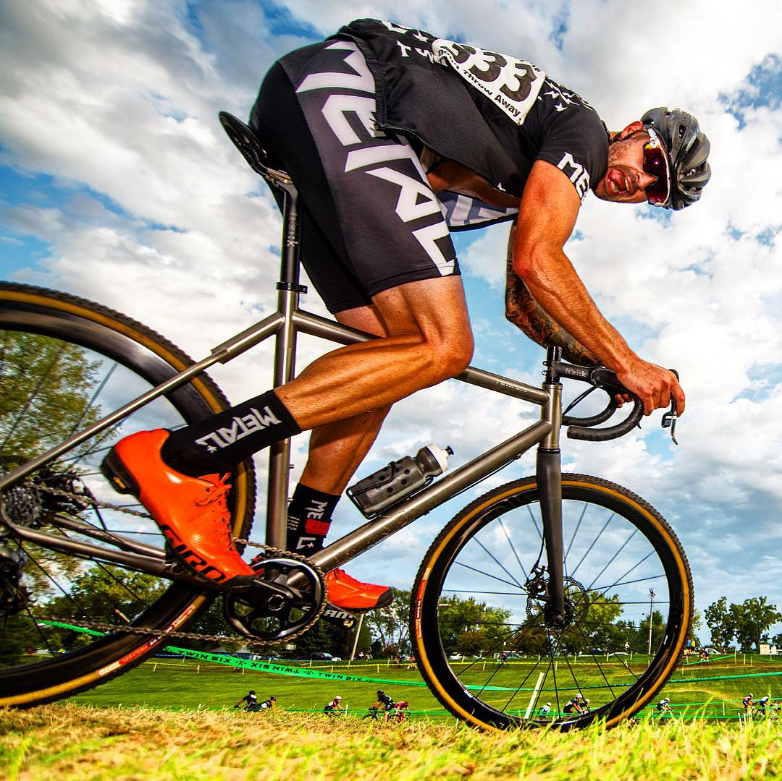Ryan Carlson (Graphic Design ‘01) was never formally trained in wicking fabrics, business best practices, or bicycle engineering; but since its launch in 2005, his company Twin Six has expanded from on-trend cycling apparel to a full line of accessories and gear—most recently, a line of bicycles.

In this interview, Carlson shares lessons learned from running a business without a business plan and advice for budding entrepreneurs.
When did you know it was time to quit your “day job” and run Twin Six full-time?
The transition to quitting my job was not an easy decision. My degree was in design, I had a great job at a big agency, and I was fortunate enough to be working on a lot of really cool projects. I loved my job, the people, the non-9-to-5-ness of it all, and the whole vibe of the local design community.
But there was the other thing now, the newness of which was very alluring. My business partner Brent Gale and I had created something that had potential, and I wanted to see it through. Worst case scenario, I could always work my way back into the advertising and design world. But I couldn’t bear the thought of not knowing what would have been if I only had the courage to jump in with both feet—so I did.
Does your team include any apparel designers / textile specialists / mechanics / bike builders? Or did you and your partner develop those skills as you grew?
We’ve all had to develop new skills as the company has grown. My business partner and I have no formal business training, which might sound comical. And no, there was never a business plan. At the end of the day, you just have to know how to solve problems. We are designers in pretty much every sense of the word: we solve problems and we make things up.
It started with “How do you start a business?” We used to meet at a coffee shop and make giants lists of questions: “How do you trademark something? Who makes private-label cycling apparel? What do we need to create an online store? When do we know it’s time to hire help?” Twelve years after officially starting this adventure, we now have four additional employees and a 6,000 square foot warehouse in St. Louis Park. It’s a pretty tight little efficient machine right now, firing on all cylinders. Divide and conquer is the name of the game.
When and why did you decide to branch out from clothing and gear to bicycles? What is your role in designing the bikes?
We had done bike collaborations before – visually designing the graphics of bikes for WaltWorks, Raleigh, and Handsome. But going back to the reason this whole thing started—to design clothes we actually wanted to wear—we thought it was time to design and produce bikes that reflected that same philosophy. Nearly all other bike companies do this the other way around: starting with bikes, and pushing into clothing.
We knew we’d need to do some serious work to convince people we knew what we were talking about and had taken the time to genuinely craft things start to finish. These are not just stamped out generic frame sets. For almost two years, we got up to speed on the whole process of making bikes; from geometry, to materials, to sourcing, to the differences between manufacturing in the states versus overseas. After a lot of R&D, time, and money, we could not be more happy with our current assortment of bike options and how they’re selling.
What advice do you have for students or recent graduates who are interested in starting their own businesses?
Do it. But maybe not right away. I had the good fortune of working for a small business owner right out of college. During my last year of school, I interned for Derek Sussner (Design Communication ‘96) at Sussner Design Company. I was made very aware of the work ethic needed to operate a successful business. As the owner, he still designed a ton of work during the day, but often times could be found back at the office late at night going through estimates and invoices.
When Brent and I first discussed starting this business, I think we fantasized about taking a month or two to design stuff, then sending off files and having it all produced, selling it, and then riding our bikes for the other eight months of the year. Obviously that’s not how it works. And today, with a wife and three small kids, time is very precious. Luckily, I have the ability to function with only three to four hours of sleep, and I am a workaholic. I jam as much stuff into every day as possible. And that seems to be the same mode of operation for other business owners I know: never not working. If you love to work, start a business. But work for someone else for a while first.
All photos © Twin Six.
What started as a collaboration between two apparel design students has turned into a small business for College of Design alumni Heidi Woelfle (B.S. ’16, Apparel Design), Regena Yu (B.S. ’16, Apparel Design) and Abby Zamis (B.F.A. ’16, Graphic Design).
When Simon Ozbek (MS '20, Human Factors & Ergonomics) started his academic career he never could have imagined that it would take him all the way to NASA. Determined to unite his passions for psychology and creativity, he discovered the College of Design’s Human Factors & Ergonomics graduate program. Now a human factors engineer at NASA, Ozbek describes his journey into the field in the following interview.
Kathryn Sterner Sieve (Apparel Design ‘11) founded Winsome Goods with an emphasis on sustainability, craftsmanship, and connecting people to the story behind their clothes.





